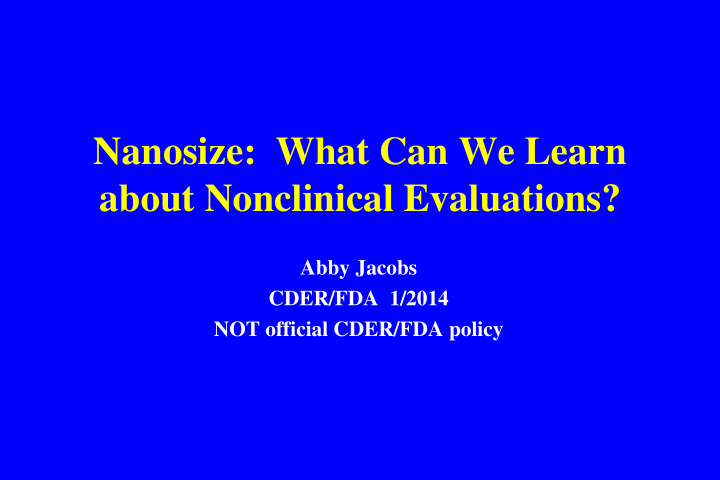



Nanosize: What Can We Learn about Nonclinical Evaluations? Abby Jacobs CDER/FDA 1/2014 NOT official CDER/FDA policy
The Interplay Between Characterization and Toxicology (a) • How do we know the material has been made reproducibly? • How do we know that the material is representative of what humans will be exposed to? • What are all the different factors, vehicles, and media that affect the aggregation and surface properties of the drug – in vitro and in vivo?
The Interplay Between Characterization and Toxicology (b) • How should the dose in a nonclinical study be described? • Not only mg/kg or mg/m 2 • Surface properties • Protein binding properties • Since there is always a particle size distribution, to what particle size range should we attribute various biologic effects?
Particle Properties (a) • Changes in which properties could affect biologic properties? • Slight differences in physical properties could impact tox
Particle Properties (b) • Biodegradable carrier vs NON biodegradable • Water soluble carrier vs NON water soluble • Stability/aggregation at stomach pH • Stability/aggregation in blood • Stability/aggregation under in vitro conditions
Route-specific Issues (a) • Inhalation – Local/respiratory toxicity – Distribution in respiratory tissues – Systemic bioavailability • SC – Sensitization
Route-specific Issues (b) • Dermal – Dermal and systemic bioavailability – Increased hair follicle penetration – Distribution to local lymph nodes – Different effects in sunlight (TiO 2 and ZnO sunscreens)
Route-specific Issues (c) • IV – Liposome may have different tissue distribution and longer half-life of API – Hemocompatability – Sterility • Ocular – Intravitreal retention
Route-specific Issues (d) • Oral • Increased bioavailability for milled products • Other than possible local effects and an increased absorbed dose, if the original tox studies were adequate, new effects are not expected – Drugs may interact with receptors at the single molecule level, so particle size would not be expected to play a role
Where Do the Various Parts of Particle Products Go (a)? • Can drug components and or carrier now cross the blood brain barrier? • Reach the fetus when it didn’t previously? • Enter other cells when it didn’t previously– and stay there?: erythrocytes • What types of assays, short of in vivo studies, could be used to address some of these questions?
Where Do the Various parts of Particle Products Go (b)? • Internalization by tumor cells? • Accumulate in spleen or other tissues? • Does tissue/cellular distribution change with differences in particle size between 10 and 100 nm? • Will it be case by case?
Are Standard Tests (ADME and Tox) and Route-Specific Studies Sufficient (a)? • New products, carriers, linkers or combinations vs milled previously marketed products of larger particle size • New products would be thoroughly tested • How much testing is needed for milled versions of previously tested and marketed products? – ADME and a tox bridging study?
Are Standard Tests (ADME and Tox) and Route-Specific Studies Sufficient (b)? • Are there any situations/product types for which a standard tox studies in conjunction with tissue distribution studies, including to the placenta/fetus, would be insufficient? • Thus far we have no such examples
Are Standard Tests Sufficient? • For multifunction combination component particles, is it sufficient to test the entire product or should separate NME components also be tested at a single high dose?
In Vitro Tests (a) • Which ones could give meaningful information and when? – If particle has insoluble components? – If particles aggregate under in vitro conditions differently than under in vivo conditions? • Some in vitro assays suggest problems not seen in vivo (by respiratory and dermal routes of administration)
In Vitro Tests (b) • Are any of the tests used for medical devices helpful? – Biocompatability for inert carriers? – Cytotoxicity? • Perhaps as a screen by the developer of the product • To look at manufacturing changes to decide if more tox is needed
Possible Use of Toxicogenomics, When Standardized • To test multifunction combination component particles vs the entire product • To compare various sizes of nanosize particles vs large sized particles • To look at manufacturing changes
Considerations (a) • Standard in vivo tests would generally address the safety concerns • Of more than 25 drug products that are currently nanosize, no indication that standard analyses are inadequate to detect any different tissue distribution, retention, or toxicity • However, need to follow closely as new types of nanoparticle products are evaluated
Considerations (b) • Work is needed to address the various characterization issues, which affect the tox evaluation • Work is needed to assess the utility of in vitro assays in a number of areas • Work is need to address some ADME issues • Work is needed to assess the utility of omic studies in a number of contexts
Recommend
More recommend